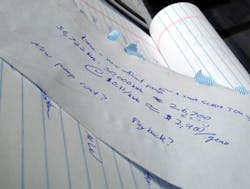Rookie Mistakes
Pitfalls to Avoid when Implementing a Wastewater Energy Management Program
By Michael Murray
Do energy savings justify initial investment? Once upon a time, evaluating an energy project was simple. For example, if I were to purchase a new motor, I would calculate:
With some rough estimation, I can conclude that energy savings equals annual energy minus annual energy. Today, however, we are finding ourselves overwhelmed with complex spreadsheets involving a number of variables before we initially assess the lifecycle costs of future energy-efficient solutions.
Likewise, in working with wastewater facilities throughout California, HelioPower's engineers found that managers tend to make four similar rookie mistakes. Here's what you need to know before you spend a dollar to save a nickel.
Buck up: Measure, Monitor & Benchmark
The most common mistake is to refrain from commissioning the upgrades, ultimately resulting in your forgetting about the program until next month's utility bill. If you are implementing an energy- efficiency project, get metrics to quantify the success. If you can't measure it, how do you know if it worked? Incorporating real-time monitoring, managerial reporting, energy project scenarios, and alerts is often the difference between demonstrated project success and failure.
Plan, Predict and Iterate Pre-Implementation
Don't just base your decision solely upon simple payback and IRR; run scenarios incorporating real-time data and calculations for your next efficiency project. Encina Wastewater Authority's 36 MGD plant shaved $50,000 per year off of its bill simply by tweaking its processing times (CEC, 2013). Some scenarios you should consider:
- Should we use system storage during the highest demand/influent periods rather than operating large pumps intermittently?
- What auxiliary and supplemental power sources would shave those hefty peak demand charges off of our bill?
- What size solar photovoltaic (PV) array could move us to a different rate structure or keep our base-load to a minimum?
- How can we build flexibility into staff schedules to accommodate peak day pricing and time-of-use (TOU) savings?
- Should we reconsider combined heat and power for the anaerobic digesters because of the TOU charges on our industrial rate plan?
It may take extra iterations and effort with utility-rate experts, but when the purchase price of a new motor could potentially be less than 2 percent of the lifecycle cost, you cannot ignore process planning.
Granularize Success: From Black-Box Gremlin to Unit Cost of Goods Sold
We all know that bugs don't work twice as hard at 4.0 ppm as they do at 2.0 ppm dissolved oxygen (DO), but how much extra are we paying per MGD for that excessively high DO level? Today, key performance indicator (KPI) software and monitoring devices allow facilities to treat energy as a cost of goods sold per unit of output. Make sure you incorporate KPIs, such as kWh/MGD or g NH4 removed/kWh -- for aeration and total, to make black-box fixed costs a thing of the past.
Unfreeze. Change. Refreeze.
Without new processes, new technology is useless. Persuading people to adopt process change is often difficult. Start by demonstrating the need for change with supporting numbers and help them come to the same conclusion. Challenge operators and facility managers to question their reasoning for decisions, asking:
- How did our electricity consumption change when we used more UV versus less filtration?
- How does our cost/MGD change when we run pumps at capacity instead of partially loaded?
- Would it be more economical to run the main pumps continuously at night rather than the 4th and 5th demand pumps intermittently during the day?
A measurement and verification platform allows you to advocate for change with data. Turn the solid process into something fluid (an idea), change the process and make it concrete again with reinforced new procedures.
If you're like me, you've utilized the spreadsheet method countless times, but with today's increasingly complex rate structures, it is easier than ever to be precisely incorrect. By avoiding the rookie mistakes and using tools like measurement and verification, we can walk away saying, "I know that worked, and here's how."
About the Author: Program Manager and Senior Energy Engineer Michael Murray developed his analytic skills at Lockheed's "Skunk Works" division as a Flight Test Engineer. Murray is currently leading development of HelioPower's PredictEnergy™, a consultative software energy solution. With over 30 years of experience in engineering and finance, Michael oversees business process consulting, analytics and demand-side management projects for HelioPower's largest clients. He holds CEM, CDSM and LEED certifications as well as a BS in Engineering from Cal Poly, San Luis Obispo.


